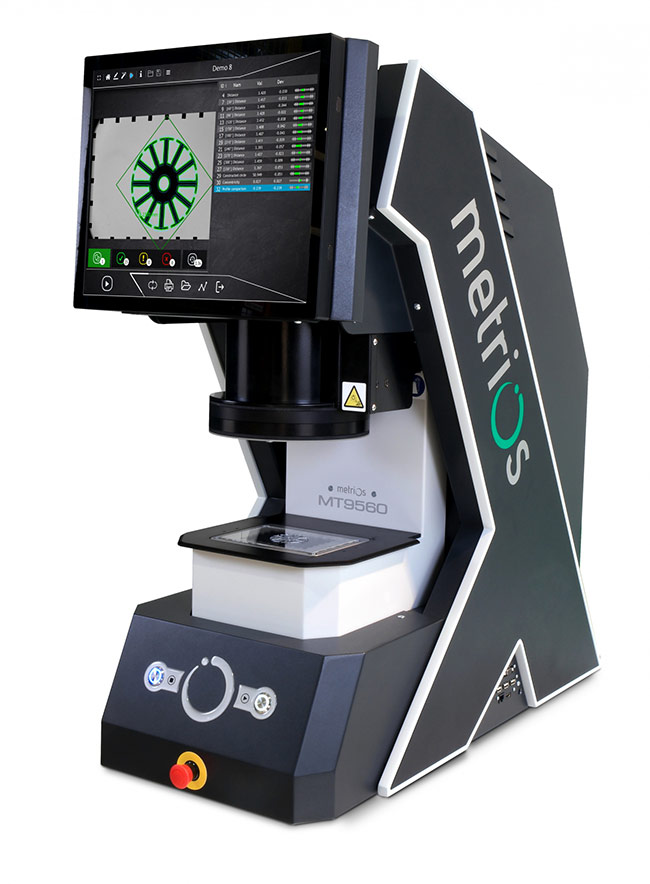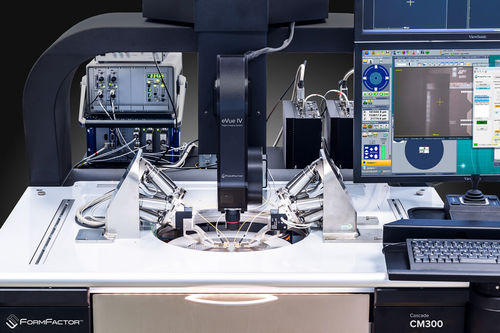Improve product reliability with optical measurement during final inspection stages
Improve product reliability with optical measurement during final inspection stages
Blog Article
The Role of Optical Dimension Systems beforehand Metrology Strategies
Optical measurement systems have transformed assessment, bringing a level of accuracy that was as soon as inconceivable. You may be amazed to discover how these modern technologies, based on fundamental principles like reflection and disturbance, are applied across various industries. Their non-contact capabilities not only improve precision but also improve procedures. As you check out better, you'll uncover how these systems are shaping the future of measurement and quality control.
The Evolution of Width: A Historical Point Of View
As you discover the background of metrology, you'll find that its evolution shows humankind's mission for precision and standardization. From old people using body parts as systems of measurement to the advancement of standard weights and steps, each step reveals our desire for precision. The Egyptians constructed the pyramids making use of precise dimensions, while the Romans progressed design with their innovative measuring tools.
During the Renaissance, scientific innovations changed the emphasis towards a lot more empirical methods, leading the way for modern assessment. The introduction of the metric system in the late 18th century noted a substantial landmark, establishing global requirements. Throughout the 20th century, technical innovations additionally transformed assessment, allowing extremely precise measurements in various areas.
Today, assessment proceeds to progress, incorporating electronic innovation and automation. This history highlights not simply the value of dimension yet likewise our relentless search of enhancing precision and consistency in our increasingly complicated globe.
Concepts of Optical Dimension Solutions
Understanding the concepts behind optical dimension systems is vital for precise cause width. You'll desire to take into account essential optical principles, measurement accuracy variables, and effective system calibration techniques. Each of these components plays a vital role in guaranteeing your measurements are dependable and specific.
Fundamental Optical Concepts
While exploring optical measurement systems, you'll experience fundamental optical concepts that develop the backbone of accurate information acquisition. Light acts in foreseeable means, and understanding these habits-- like refraction, reflection, and diffraction-- is important for effective dimensions. By grasping these principles, you'll be equipped to utilize optical technologies successfully, paving the way for developments in width and ensuring your measurements are both repeatable and trustworthy.
Dimension Accuracy Factors
To accomplish high measurement accuracy in optical systems, a number of factors enter play, influencing the dependability of your results. First, the top quality of the optical parts matters greatly. High-grade lenses and detectors reduce aberrations and noise, guaranteeing your dimensions are precise. Second, ecological conditions like temperature level and moisture can impact dimensions, so maintaining a stable atmosphere is necessary. Third, the alignment of the optical system is crucial; even small imbalances can lead to substantial errors. Lastly, the wavelength of light made use of impacts the resolution and precision of your dimensions. By attending to these elements, you can improve the total performance of your optical measurement systems, bring about even more precise and trustworthy outcomes in your width applications.
System Calibration Methods
Achieving high measurement precision is only part of the formula; appropriate system calibration techniques are equally essential in optical measurement systems. To guarantee your system supplies dependable outcomes, you should consistently calibrate it utilizing typical referral materials. Beginning by adjusting the optical elements, like lenses and mirrors, to decrease organized mistakes. Next off, utilize well-known dimensions to confirm the system's output and make required improvements. It's likewise important to account for ecological aspects-- temperature level and moisture can influence measurements. Implement a routine calibration routine to keep uniformity gradually. Record all calibration treatments and outcomes; this will aid you track performance and attend to any type of drift in precision. With these strategies, you'll improve the dependability of your optical dimension system.
Trick Technologies Behind Optical Measurement
Optical measurement systems depend on numerous vital modern technologies that improve precision and performance in metrology. One essential innovation is interferometry, which makes use of the interference of light waves to measure little displacements and surface abnormalities with severe accuracy. You'll also locate laser scanning systems, which catch thorough 3D information of objects rapidly, making them vital for dimensional evaluation.
Furthermore, CCD and CMOS sensors play a substantial role in transforming light into electric signals, enabling high-resolution imaging and precise dimensions. Advanced formulas for picture handling better improve measurement precision by analyzing data in actual time, removing noise and boosting attributes.
Finally, optical fiber give flexibility and the capacity to gauge in difficult settings while maintaining signal stability. By leveraging these modern technologies, you can achieve superior outcomes in your assessment jobs, making certain that your dimensions are both accurate and reputable.
Applications of Optical Dimension in Industry
As sectors progressively require accuracy and effectiveness, the applications of optical dimension systems have actually become crucial across numerous markets. In manufacturing, these systems assist you check measurements and tolerances in real-time, ensuring quality assurance without time-consuming hand-operated checks. In the auto sector, optical measurements aid in straightening elements with accuracy, enhancing safety and security and efficiency.
In electronics, you're making use of optical approaches to check minute functions on motherboard, detecting issues that can lead to failings. The aerospace market take advantage of non-destructive screening techniques, permitting you to analyze materials and components without jeopardizing their stability.
Optical dimension additionally plays a crucial function in fabrics, making sure fabric measurements fulfill specific specs. optical measurement. With their capacity to give high-resolution information promptly, these systems encourage you to make educated choices, simplify procedures, and ultimately drive advancement throughout your sector
Enhancing Accuracy and Effectiveness in Dimensions
When you think of enhancing accuracy in measurements, accuracy in your dimension methods is important. By simplifying these procedures, you can accomplish quicker outcomes without giving up high quality. Allow's explore exactly how embracing sophisticated optical dimension systems can boost both precision and effectiveness in your job.
Accuracy in Dimension Methods
Precision in measurement strategies is necessary for accomplishing trustworthy lead site to assessment, specifically since tiny disparities can bring about substantial errors. By making use of advanced optical dimension systems, you can improve the precision of your dimensions. These systems provide high-resolution information that assist you find also the smallest variants in dimensions. You reduce unpredictabilities and improve repeatability in your processes when you take on these technologies. Furthermore, precise dimensions permit you to keep top quality control, making sure that products satisfy rigorous requirements. This not just improves your trustworthiness but likewise enhances customer satisfaction. Investing in accuracy measurement tools eventually results in increased efficiency, decreased waste, and enhanced manufacturing cycles. Embracing these techniques will transform your technique to width, generating impressive results.
Improving Dimension Processes
To enhance accuracy and efficiency in dimensions, streamlining your dimension procedures is crucial. Begin by taking on optical dimension systems that provide real-time information, reducing the moment spent on hands-on recording. These systems typically incorporate flawlessly with existing software program, enabling you to automate data collection and analysis.
Following, standardize your measurement methods. By implementing consistent procedures, you decrease irregularity and improve repeatability. Don't fail to remember to on a regular basis adjust your tools to ensure its accuracy.

The Influence of Optical Dimension on R & D
As researchers undertaking to push the limits of technology, optical dimension systems have ended up being important devices in the development process. These systems give you with specific, real-time data that enhances your ability to assess complicated products and frameworks. In different areas, from biotechnology to aerospace, you count on optical measurements to improve and maximize layouts item performance.

With high-resolution imaging and non-contact methods, you can lessen example disturbance, permitting for more accurate results. This ability to catch minute details increases your R&D cycle, letting you repeat styles rapidly and effectively. Optical dimension cultivates partnership throughout self-controls, as the information produced is typically easily interpretable and shareable.
Ultimately, incorporating optical dimension systems right into your research not only improves performance but also strengthens your understanding of the phenomena you study. By leveraging these sophisticated strategies, you're better furnished to introduce and stay ahead in an affordable landscape.
Future Patterns in Optical Measurement Solutions
With the rapid advancement of innovation, you're likely to see significant shifts in optical measurement systems that will redefine their application throughout various markets. You'll notice an action toward increased automation and assimilation of expert system, permitting real-time information evaluation and enhanced precision. Miniaturization is one more trend; compact devices will allow dimensions in tighter spaces, making them optimal for areas like aerospace and biomedical applications.
Moreover, the arrival of sophisticated products, such as photonic crystals, will certainly improve level of sensitivity and resolution. Anticipate to see systems that can operate in difficult settings, giving trusted measurements in extreme conditions. Cloud-based analytics will likewise play a vital duty, using you access to large datasets for better decision-making. As these technologies converge, you'll discover that optical dimension systems not only boost precision yet likewise streamline operations, ultimately driving technology and effectiveness in your tasks.
Regularly Asked Inquiries
Exactly How Do Optical Dimension Solutions Compare to Standard Measurement Techniques?
Optical measurement systems use greater accuracy and faster outcomes compared to typical methods. You'll locate they catch even more data points properly, decreasing human mistake and increasing reliability, making them a favored option in numerous applications.
What Industries Benefit The Majority Of From Optical Dimension Systems?
You'll locate sectors such as aerospace, vehicle, and electronic devices benefit most from optical measurement systems. These sectors rely on exact measurements to assure quality and performance, enhancing performance and decreasing prices with advanced modern technology.

Are Optical Measurement Systems Expensive to Execute?
Optical dimension systems can be expensive to implement, however their precision and efficiency you could look here often warrant the cost. Spending in such technology can result in substantial long-lasting cost savings and enhancements in top quality across different applications.
What Abilities Are Required to Run Optical Measurement Solutions?
To operate optical dimension systems, you'll need strong logical abilities, focus to information, and efficiency in software tools. Experience with optics and an understanding of dimension principles will also enhance your efficiency and effectiveness.
Exactly How Do Environmental Aspects Affect Optical Measurements?
Ecological aspects like air, temperature, and moisture quality can misshape optical measurements. You'll discover variants in precision because of light disturbance or refraction. optical measurement. Keeping steady conditions is necessary for exact and trusted optical measurement outcomes
Conclusion
In recap, optical dimension systems are changing width by giving check it out unequaled accuracy and performance. As you discover future trends, you'll see how the integration of AI and automation will continue to elevate dimension techniques, driving advancement and boosting high quality control.
Accomplishing high dimension accuracy is just component of the formula; appropriate system calibration techniques are equally vital in optical measurement systems.When you assume about improving accuracy in dimensions, precision in your dimension techniques is vital. By using advanced optical measurement systems, you can boost the accuracy of your dimensions.To enhance precision and performance in dimensions, streamlining your measurement procedures is vital. Just How Do Optical Measurement Equipments Contrast to Traditional Dimension Techniques?
Report this page